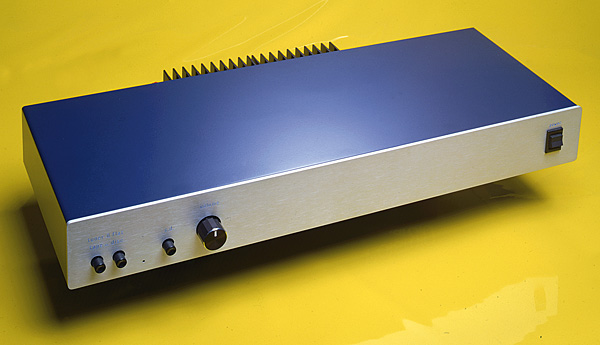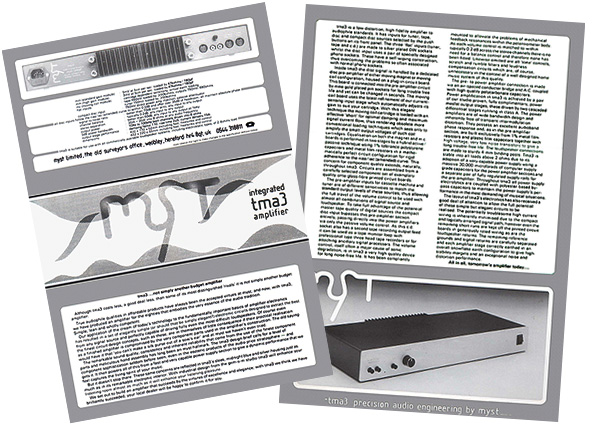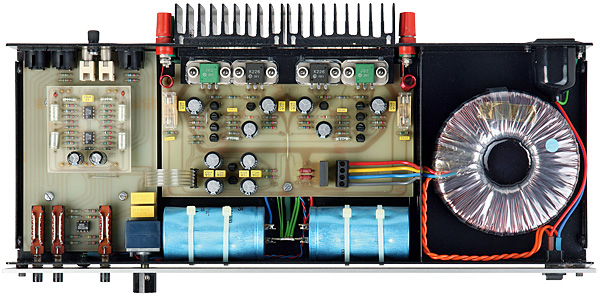Myst TMA3 amplifier Page 2
Living with a Myst TMA3 is a strangely satisfying experience. Being so small it takes up very little space on your hi-fi rack while the limited number of inputs – just phono, tape, tuner and CD – means you're forced to have a pretty pared-down system, whether you like it or not. It puts out a claimed 35W per channel into 8ohm [see PM's Lab Report], but these are a very robust-sounding 35W and would be ample to fill most small-to-medium sized British rooms with sound.

Minimalist Cool
Matched with a Rega Planar 3 turntable of the period and Wharfedale Diamond Pro mini monitors you have a system that's every inch the essence of mid-'80s minimalist cool. Myst later launched a version of the amp in satin black, which cost an extra £25 and was a perfect aesthetic match for the new wave of British hi-fi. Another iconic loudspeaker of the time was the Celestion SL6, which the TMA3 was often used with. Bizarrely, Maloney confesses that he was inspired to make the amplifier exactly the size it is to match the dimensions of the sand-filled metal uprights of the SL6's matching factory stands! One enlightened choice of partnering speaker was the Quad ESL-63, because the little Myst TMA3 was able to drive them so well.
'Those Quads were the best sounding loudspeakers of the time, by a mile,' says Michael. 'The TMA3 had the MOSFETs, the best power supply and the big toroidal transformer, and it would drive them the way they were meant to be driven. They were half the cost of a house, dramatically expensive, so I don't think many people bought TMA3s to drive Quads.
'We used the Celestion SL6 as a reference, and these and the TMA3 went together hand-in-glove. The SL6 was a very tricky speaker to drive, but Celestion heard the TMA3 in action and we began to get involved in producing an active version of the SL6. It was never a production thing, it was a skunkworks project. We had one power amp driving the two drivers, one for the woofer, one for the tweeter – and that was the bee's knees!'
![]() David Listens
David Listens
The TMA3 was well reviewed at the time, Ivor Humphreys saying 'it has no real peers and relatively few rivals' in the Aug '85 issue of HFN. Actually there were several contemporaries that this little integrated faced, including the Naim NAIT, NVA AP30, Mission Cyrus 2 and Exposure X. However, it's perfectly possible to argue that the Myst TMA3 bettered them all in one or other respect – it really is that good.

The first point to make is the amplifier's sense of confidence and assuredness. Led Zeppelin's 'Stairway To Heaven' [from IV, Atlantic 82638-2] showed the TMA3 to be smooth, even, open and surprisingly gutsy sounding considering its diminutive dimensions. It has way more power than the NAIT of that period for example, and matches the Mission Cyrus 2 in its ability to drive speakers to highish volumes. It is crisper and more detailed than the NVA AP30, and smoother and more three-dimensional than the Exposure of its day. Indeed, you could say the Myst has a quite anonymous sound in that it's not obvious that you're listening to an amplifier with any particular character at all.
The other standout feature is the amplifier's soundstaging ability, which is excellent for a product of its price and period. Not only is the sonic picture expansive, it goes back a good bit too, making most of its rivals sound shut-in, or flat.

Give the TMA3 a high quality classical music recording such as Beethoven's 'Pastoral' Symphony [Karajan, Berlin Philharmonic, Deutsche Grammophon 2531106] and it unlocks the dimensions of the concert hall in a way that the Naim NAIT could only dream of. The amp's effortlessness allied to the size of the soundstage is beguiling.
Then there's its grip. Although it's quoted at just 35W per channel, it grabs the bass cones of loudspeakers with the tenacity of a terrier ripping up a rag doll. The quoted damping factor of 110 alludes to this – it makes repetitive beat-driven music a whole heap of fun as you bask in the sense of pace and propulsion. Indeed the TMA3 can get quite 'kinetic' with the right, bass-heavy electronic dance music such as Kraftwerk's 'The Robots' [from The Man Machine, EMI CDEMS 1520], pushing out vast tracts of low frequencies in an apparently unflustered way, bang on time.
It's all the more hilarious when your eyes glance up to see this tiny silver-and-blue box doing all the heavy lifting. What's more, even at highish volumes the amp stays smooth and civilised-sounding, while still being able to pile on the thrills.

Buying Secondhand
Some rival brands make great play of the fact that you can send their amplifiers back for periodic servicing, but Michael Maloney is dismissive of this. He argues that the TMA3 used top quality components so there's little need for it.
Choosing the right sample of the amp to buy secondhand is thus a more straightforward task than might be the case with some vintage models. The thing to look out for is cosmetic condition as battle scars on the casework will indicate a punishing life. Switch and volume pot contacts are the other worry since lack of use can cause them to become noisy.
Hi-Fi News Verdict
Although the TMA3 was Myst's most affordable product, it has proved extremely reliable over the years. Examples still surface secondhand from time to time, costing upwards of £250 for a mint example, which is both a hi-fi bargain and an appreciating asset. Any new owner will soon discover that this little amplifier has bags of charm, and harks back to a simpler age in audio when less really was more.


























































